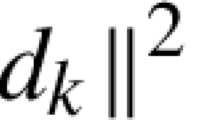Abstract
This paper considers the problem of minimizing a functionalI which depends on the statex(t), the controlu(t), and the parameter π. Here,I is a scalar,x ann-vector,u anm-vector, and π ap-vector. At the initial point, the state is prescribed. At the final point, the state and the parameter are required to satisfyq scalar relations. Along the interval of integration, the state, the control, and the parameter are required to satisfyn scalar differential equations.
First, the case of a quadratic functional subject to linear constraints is considered, and a conjugate-gradient algorithm is derived. Nominal functionsx(t),u(t), π satisfying all the differential equations and boundary conditions are assumed. Variations Δx(t), δu(t), Δπ are determined so that the value of the functional is decreased. These variations are obtained by minimizing the first-order change of the functional subject to the differential equations, the boundary conditions, and a quadratic constraint on the variations of the control and the parameter.
Next, the more general case of a nonquadratic functional subject to nonlinear constraints is considered. The algorithm derived for the linear-quadratic case is employed with one modification: a restoration phase is inserted between any two successive conjugate-gradient phases.
In the restoration phase, variations Δx(t), Δu(t), Δπ are determined by requiring the least-square change of the control and the parameter subject to the linearized differential equations and the linearized boundary conditions. Thus, a sequential conjugate-gradient-restoration algorithm is constructed in such a way that the differential equations and the boundary conditions are satisfied at the end of each complete conjugate-gradient-restoration cycle.
Several numerical examples illustrating the theory of this paper are given in Part 2 (see Ref. 1). These examples demonstrate the feasibility as well as the rapidity of convergence of the technique developed in this paper.
Similar content being viewed by others
References
Heideman, J. C., andLevy, A. V.,Sequential Conjugate-Gradient-Restoration Algorithm for Optimal Control Problems, Part 2, Examples, Journal of Optimization Theory and Applications, Vol. 15, No. 2, 1975.
Miele, A., Pritchard, R. E., andDamoulakis, J. N.,Sequential Gradient-Restoration Algorithm for Optimal Control Problems, Journal of Optimization Theory and Applications, Vol. 5, No. 4, 1970.
Miele, A., Huang, H. Y., andHeideman, J. C.,Sequential Gradient-Restoration Algorithm for the Minimization of Constrained Functions, Ordinary and Conjugate Gradient Versions, Journal of Optimization Theory and Applications, Vol. 4, No. 4, 1969.
Lasdon, L. S., Mitter, S. K., andWaren, A. D.,The Conjugate Gradient Method for Optimal Control Problems, IEEE Transactions on Automatic Control, Vol. AC-12, No. 2, 1967.
Horwitz, L. B., andSarachik, P. E.,Davidon's Method in Hilbert Space, SIAM Journal on Applied Mathematics, Vol. 16, No. 4, 1968.
Pagurek, B., andWoodside, C. M.,The Conjugate Gradient Method for Optimal Control Problems with Bounded Control Variables, Automatica, Vol. 4, Nos. 5–6, 1968.
Lasdon, L. S.,Conjugate Direction Methods for Optimal Control, IEEE Transactions on Automatic Control, Vol. AC-15, No. 2, 1970.
Tripathi, S. S., andNarendsa, K. S.,Optimization Using Conjugate Gradient Methods, IEEE Transactions on Automatic Control, Vol. AC-15, No. 2, 1970.
Sinnott, J. F., Jr., andLuenberger, D. G.,Solution of Optimal Control Problems by the Method of Conjugate Gradients, Proceedings of the Joint Automatic Control Conference, Philadelphia, Pennsylvania, 1967.
Bliss, G. A.,Lectures on the Calculus of Variations, The University of Chicago Press, Chicago, Illinois, 1946.
Hestenes, M. R.,Calculus of Variations and Optimal Control Theory, John Wiley and Sons, New York, New York, 1966.
Miele, A., Editor,Theory of Optimum Aerodynamic Shapes, Academic Press, New York, New York, 1965.
Miele, A.,Method of Particular Solutions for Linear, Two-Point Boundary-Value Problems, Journal of Optimization Theory and Applications, Vol. 2, No. 4, 1968.
Miele, A., Heideman, J. C., andDamoulakis, J. N.,The Restoration of Constraints in Holonomic and Nonholonomic Problems,Journal of Optimization Theory and Applications, Vol. 3, No. 5, 1969.
Author information
Authors and Affiliations
Additional information
Communicated by A. Miele
This research was supported by the Office of Scientific Research, Office of Aerospace Research, United States Air Force, Grant No. AF-AFOSR-72-2185. The authors are indebted to Professor A. Miele for stimulating discussions.
Formerly, Graduate Studient in Aero-Astronautics, Department of Mechanical and Aerospace Engineering and Materials Science, Rice University, Houston, Texas.
Rights and permissions
About this article
Cite this article
Heideman, J.C., Levy, A.V. Sequential conjugate-gradient-restoration algorithm for optimal control problems. Part 1. Theory. J Optim Theory Appl 15, 203–222 (1975). https://doi.org/10.1007/BF02665293
Issue Date:
DOI: https://doi.org/10.1007/BF02665293




